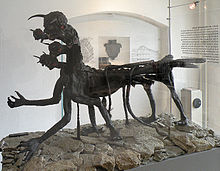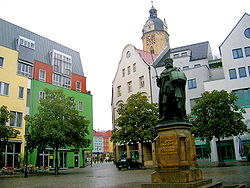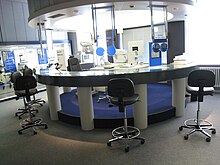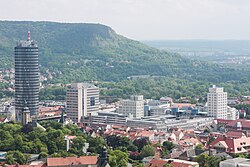Jena is a city in the central German state of Thuringia (Thüringen). It is a centre of science and technology with a reputable university, several research institutes and high-tech plants, especially focusing on precision mechanics and optical industries. About a fourth of the population are students.
Understand
editJena (pronounced yay-nah) has probably existed since at least the 9th century AD and became a town around 1230. Part of the State of Thuringia from its foundation in 1920 on, it was incorporated into the German Democratic Republic (East Germany) in 1949 and its district of Gera in 1952. Since 1990, the city of Jena has again been a part of reunited Germany's state of Thuringia.
Academics
edit
Jena has the biggest university in Thuringia and its ratio of students to the total of inhabitants is one of the highest in Germany, as there are 20,000 students at the university which was founded in 1558 and named after Friedrich Schiller in 1934. Additionally, there are some 4,500 students at the university of applied sciences (Fachhochschule), making one out of four citizens of Jena a student.

In early modern times, there was a fix canon of sights—the Seven Wonders of Jena, or septem miracula Jenae in Latin—that each student in Jena was expected to visit and remember. Being able to identify and recite the Seven Wonders in the correct order was considered a proof that someone had indeed studied at Jena: Ara ("arch"—the underpass below the altar of St Michael's church), Caput ("head"—the mechanically moving figure head above the astronomical clock at the townhall), Draco ("dragon"—a seven-headed chimera made as a student joke of animal bones and papier-mâché), Mons ("mountain"—the 385 metre-high Jenzig hill northeast of the town), Pons ("bridge"—the nine-arched old stone bridge Camsdorfer Brücke over the Saale), Vulpecula Turris ("fox tower"—Fuchsturm, a high-medieval donjon on a hilltop east of Jena), Weigeliana Domus ("Weigel's house"—das Weigelsche Haus, built for a 17th-century professor of mathematics with many technical refinements that were considered ahead of the time, like a wine conduit from the cellar to the dining room, a mechanical lift and long tubes for the observation of stars). Five of the wonders are still extant, while the bridge and Weigel's house are lost.
Johann Wolfgang Goethe and Friedrich Schiller, probably the two greatest German writers, lived in Jena for a few years (though their residence in Weimar is much more well known). Around 1800, Jena was the birthplace of German idealist philosophy (developed by Johann Gottlieb Fichte and Friedrich Wilhelm Joseph Schelling) and early romantic literature ("Jena Romanticism", created by authors like Novalis, Friedrich and Wilhelm Schlegel). Other famous citizens of Jena include the biologist Ernst Haeckel, the physicists Ernst Abbe and Erwin Schrödinger. The philosopher and communist thinker Karl Marx obtained his Ph.D. from Jena University (because it was one of the few at that time to accept dissertations written in German instead of Latin) without ever attending a course there.
Napoleon
editIn 1806, Jena and the village of Auerstädt (25 km north of the city) were the sites of a decisive battle in the War of the Fourth Coalition (Napoleon's war against Prussia), involving more than 220,000 soldiers. One of the most known bridges over the Seine and a boulevard in the 16th arrondissement of Paris are named after Jena in memory of this French victory: Pont d'Iéna and Avenue d'Iéna.
Optical and high-tech manufacture
editJena is also famous for Carl Zeiss, an optical and precision engineering company founded in 1846, and the Schott hightech glass factories founded in 1884. Both have long been leading players of their respective sectors and exporting worldwide. "Jenaer Glas" is a brand of refractory and chemically resistant glass developed by Otto Schott in 1887. Under the management of socially-minded Ernst Abbe, the Zeiss works (and likewise Schott) provided their employees with quite far-reaching social security and benefits, like pension funds and eight-hour days, that were considered radically modern in the 19th century. This generated a very high identification of workers with their respective company and made Jena a forerunner of Germany's "social market economy". In 1942 Jena was the first site to produce penicillin on an industrial scale, leading to the establishment of the pharmaceutical company Jenapharm. Both Schott's and Carl Zeiss' plants were nationalised in communist East Germany after 1945, while the seat of the respective corporation was moved to capitalist West Germany (establishing new production sites under the traditional names in Mainz and the Swabian Mountains, respectively).
The former nationally-owned factories of Schott and Carl Zeiss were (partially) reunited with their Western counterparts after the end of Cold War, but their executives are still based in (South-)Western Germany rather than moving back to Jena. Some branches of Carl Zeiss Jena have however been outsourced as an independent company called Jenoptik with headquarters in Jena, that has become a renowned producer of laser technology and optical instruments, as well. Similarly, Analytik Jena has specialised on (bio-)analytical instruments. The overall number of workers drastically declined after reunification. Nevertheless, Jena has attracted considerable investments into its manufactories and research institutes and is now considered one of the economically most successful cities of former East Germany, well keeping up with the times. Carl Zeiss Meditec, a Carl Zeiss subsidiary producing medical technology like surgical microscopes or instruments for eye exams, is headquartered in Jena since 2002, being one of four listed companies based in this city (and one of the highest-grossing).
Get in
editBy plane
editThere are two small airports in Altenburg (east of Jena) and Erfurt (west of Jena), but the former has no scheduled passenger traffic while the latter is only used by charter flights to Mediterranean holiday destinations.
Coming from far away you will most probably arrive at Frankfurt airport. From there you can either take the ICE high-speed train to Erfurt and then change to a regional train going to Jena (c. 3:15 hours in total), or you can go by car via Autobahn A5 and A4 straight towards Jena. This is approx. 300 km (about three hours during average traffic).
By train
editSince the completion of the Leipzig/Halle–Erfurt–Nuremberg high-speed route, Jena is bypassed by most ICE and intercity trains. Once a day each, there is an ICE high-speed train from Hamburg (4 hr 20 min) via Berlin (2½ hr) and an intercity from Stuttgart (almost 5 hr) via Nuremberg (2½ hr). Both of them also stop in Leipzig (1 hr 10 min). Otherwise, you will have to change from high-speed to regional trains either in Erfurt (half-hourly regional trains to Jena, taking half an hour), in Halle (two-hourly, 1 hour) or Leipzig (two-hourly, 1 hr 25 min).
All trains from Erfurt also stop in Weimar from where it takes only a 15 minutes ride to Jena. Morever Jena is served by hourly regional express trains from Gera (half hour) and two-hourly from Göttingen (2 hr 10 min) via Gotha (50 min), from Altenburg (1 hr 20 min) or from Glauchau near Chemnitz (1½ hr).
The city's main station is called 1 Paradies-Bahnhof (literally "paradise station", as the surrounding park is called Paradies).
Regional trains from Erfurt, Weimar or Gera arrive at 2 West-Bahnhof (Western station).
By car
editJena is not far from the Hermsdorfer Kreuz where the A9 (E49/E51) from Berlin to Munich and the A4 (E40) from Frankfurt to Dresden cross. Just take the way towards Erfurt/Frankfurt and you will reach Jena within minutes.
Get around
editYou can reach all important destinations by walking. You can also use public transportation (buses and trams), but it is not cheap in Jena. Details at Jenaer Nahverkehr GmbH.
See
edit
- 1 Markt (market square). Centre of the old town, surrounded by historical buildings. The townhall dates from the 14th century. Its astronomical art clock was added in the 15th century, with Schnapphans, a mechanically moved figure opening and closing his mouth every full hour, in the attempt to catch a Thuringian dumpling on a stick. Jena is said to be doomed if Schnapphans ever catched the dumpling.
- 2 Göhre (Stadtmuseum—Museum of local history), Markt 7, ☏ +49 3641 498261. Tu W F 10:00-17:00, Th 15:00-22:00, Sa Su 11:00-18:00, closed on Mondays. Located in a historical building whose foundations date from the 13th century but was completely rebuilt in a Gothic revival style around 1900, then serving as a wine shop and wine bar. The museum illustrates the history of Jena from pre-history to the 19th century on four levels. The exhibits include a seven-headed "dragon" modelled from animal bones and papier-mâché by students in early 17th century that was considered one of the "Seven Wonders" of Jena.
- 3 St Michael's church (Stadtkirche St. Michael). Main Protestant parish church of the city. There probably was a church at this location as early as in the 12th century. The present building was started around 1380 and is a late-Gothic hall church. The 75-metre-high octogonal tower is topped by a Renaissance-style crest. An architectural anomaly is the underpass below the church's sanctuary and altar that served as the only passage to the (long disbanded) Cistercian convent behind the church during medieval and early modern times and was considered one of the "Seven Wonders" of Jena.

- 4 Schiller's garden house, Schillergäßchen 2. Friedrich Schiller, one of the greatest classical German poets and playwrights lived in Jena from 1789 to 1799 with his wife Charlotte von Lengefeld, a native of nearby Rudolstadt. While Schiller's downtown home is lost, the garden house that he bought in 1797 to spend the Summers with his family outside the town (at that time) still exists. Some of Schiller's most notable works—the dramas "Wallenstein", "Mary Stuart" and "The Maid of Orleans" as well as several ballads—were created (at least in parts) in the study of this house. It now serves as a museum run by the Friedrich Schiller University with an exhibition dedicated to Schiller's years in Jena.
- 5 Schillerkirche, Schlippenstraße 32 (East Jena (Wenigenjena), Tram 2, 3, 33 "Schlippenstraße"). Protestant one-aisled church from the 14th to 15th century, actually dedicated to Our Lady (Mary) but renamed after Friedrich and Charlotte von Schiller who married here in 1790.
- 6 Anatomieturm (Anatomy Tower). Ruined round tower that used to be part of Jena's town fortification. The remaining base once supported an anatomical theatre (hence the name) where courses for medical students took place and Goethe (who was not just a writer but also a scientist) did research on the premaxillary bone of humans and elephants.
- 7 Johannistor (John's Tower). Gothic gate tower, another—much better preserved—part of the medieval fortifactions. It is linked with the nearby magazine (Pulverturm) by a reconstructed wall walk.

- 8 Botanical Garden (Botanischer Garten), Fürstengraben 26, ☏ +49 3641 949274, botanischergarten@uni-jena.de. Apr–Oct daily 10:00-19:00, Nov–Mar daily 10:00-18:00, closed on Christmas Eve and New Year's Eve. Second-oldest and one of the most famous and most beautiful botanical gardens in Germany. Admission €5, reduced €3.
- 9 Volkshaus ("house of the people"), Carl-Zeiss-Platz 15. Funded by the Carl Zeiss foundation and opened in 1903, it was one of Germany's first free educational and cultural venues targeting working-class people. Today, the imposing historicist building is still used for meetings, cultural events, educational presentations as well as being home to the Ernst Abbe library and the Jenaer Philharmonie orchestra.

- 10 Optisches Museum Jena (Optical museum), Carl-Zeiss-Platz 12, ☏ +49 3641 443165, info@optischesmuseum.de. closed for renovations until 2023. Comprehensive exhibition illustrating the development of optical instruments and technology through the ages, focusing on the work of physicist Ernst Abbe and entrepreneurs Carl Zeiss and Otto Schott and their respective companies. English-language guides available by prior appointment (€40 for the whole group), audioguides in English, French, German, Italian and Japanese (€1 per person plus €5 deposit). Admission €5, reduced €4. Combi tickets for the Zeiss planetarium available.
- Paradies (close to the centre of Jena). Nice park, especially in the summer a lot of students use this park for barbecue and hanging out with their friends.
- 11 JenTower (formerly known as Intershop Tower). 144.5-m-high office tower built in the early 1970s for the university and intended by the communist rulers to be a dominant part of the "socialist city". It was designed by Hermann Henselmann (architect of the Berlin television tower) to remind of an upright telescope (alluding to Jena's optical industries). It was renovated and modernised around 2000, receiving its characteristic glass façade. Main tenant of offices is the e-commerce developer Intershop. There is a restaurant on the highest floor and an observation platform on the top. Visit of the observation platform €3.
- 12 Napoleonstein (Napoleon stone) (on Windknollen hill, 3 km north of the city centre). Memorial at the site of the Battle of Jena in 1806.
Jena is surrounded by hills. Hence there are a lot of very nice opportunities to get a beautiful panorama view of the town. From the towers or the restaurants Wilhelmshöhe and Landgrafen.
Do
edit
- 1 Zeiss-Planetarium, Am Planetarium 5 (parking space around the planetarium is scarce), ☏ +49 3641 885488, order@planetarium-jena.de. Founded in 1926 using Carl Zeiss technology, it is one of the oldest projection planetariums in the world. There are educational programmes, entertaining programmes for families, music shows and film screenings. Educational and family programmes €8.50, reduced €7.
- 2 Theaterhaus Jena, Schillergässchen 1, ☏ +49 3641 8869-0, info@theaterhaus-jena.de. Municipal theatre, staging dramas, musical and dance theatre. Standard ticket €18, reduced €9; special offers may be cheaper.
- 3 Jenaer Philharmonie (Jena philharmonic orchestra), Carl-zeiß-platz 15, ☏ +49 3641 498101. Classical orchestra that cooperates with a philharmonic choir, boys choir and madrigal choir. Their concerts usually take place at the Volkshaus. Tickets for symphony concerts €24–29, reduced €20–24 (€1 discount if bought in advance); chamber concerts €16, reduced €12.
Events
edit- Kulturarena: . A very popular summer cultural event in July-August with dozens of good international artists and entertainers. (date needs fixing)
Buy
editTake a look at GoetheGalerie or Neue Mitte. Here you can find almost anything you need. Another places for shopping are the shopping centres Burgaupark and Schillerpassage.
- 1 GoetheGalerie. One of the largest shopping malls in Jena.
- 2 Neue Mitte, Leutragraben 1, ☏ +49 3641 208000. M-Sa 8ː00-20ː00, Su closed. Large shopping mall.
Eat
edit
As Jena is a student town and a town in the east of Germany, prices are slightly lower than in Western Germany.
Thuringian specialties are: Thüringer Rostbratwurst (Thuringian roaster sausage), Rostbrätel (roasted meat). These can be found at the Grillteufel food stalls.
Street food
edit- 1 Grillteufel Goethe Galerie, Schillerstraße.
Budget
editAll these are in the city centre:
- 2 Café Immergrün, Jenergasse 6. A very pleasant place with student atmosphere.
- 3 FritzMitte - Stefan Lindloh, Neugasse 5.
- 4 Cafeteria Zur Rosen, Johannisstraße 13.
- 5 Die Kneipe, Wagnergasse 10.
- 6 Bistro-Alibaba Jena, Lutherstraße 3A.
- 7 FritzMitte - Stefan Lindloh, Johannispl. 21.
- 8 Hanoi Express, Grietgasse 2A, ☏ +49 3641 227551. Vietnamese cuisine. Dishes are prepared in the open show kitchen.
Mid-range
edit- 9 Stilbruch, Wagnergasse 1-3. Known to be among the best restaurants in Jena.
- 10 Fuchsturm Jena, Turmgasse 26.
- 11 Wilhelmshöhe, Burgweg 75.
- Noll, Oberlauengasse.
Splurge
edit- 12 Landgrafen, Landgrafenstieg 25, ☏ +49 3641 507071.
- 13 Scala Restaurant Jena - JenTower 27.-29. OG, 27–29 JenTower, Leutragraben 1.
Drink
edit- 14 Quirinus, Jenergasse 1, ☏ +49 3641 3464916. An atmospheric cafe.
You should taste black (dark) beer. In all restaurants you will either get Köstritzer or Schwarze Rose. Both are good. You will find many Pils sorts as well.
- 1 Gruenowski, Schillergaesschen 5 (behind the theatre), ☏ +49 3641 446620. A lively pub which also serves food.
- 2 Papiermühle, Erfurter Str. 102, ☏ +49 3641 45980. Beer brewed in Jena.
Enjoy nightlife at
- Wagnergasse.
- 3 Rosenkeller, Johannisstraße 13, ☏ +49 3641 9400925.
- 4 Kassablanca, Felsenkellerstr. 13a (near Westbahnhof), ☏ +49 3641 28260.
Sleep
edit
Accommodation can be booked through the tourist information:
- 1 Jena Tourist-Information, Markt 16, ☏ +49 3641 498066, fax: +49 3641 498055, zimmer@jena.de. M-Sa 10ː00-18ː00, Su closed.
A list of accommodation options can be found at on the towns tourist website
Budget
edit- 1 Jugendgästehaus (youth hostel), Am Herrenberge 3 (To get there, take bus line 10,13 or 40 from Teichgraben or Westbahnhof (Western train station) with direction Burgau. Get off at Zeiss-Werk. From there, it is 800 metres by foot slightly uphill along Mühlenstraße.), ☏ +49 3641 687230, fax: +49 3641 687202, JGH-Jena@internationaler-bund.de. Room rates including breakfast: single room €27.50, double room €41, dorm (3 or 4 beds) from €18.50 per person.
Mid-range
edit
There are lots of good hotels with reasonable prices. Places located in Old Town include:
- 2 Restaurant & Hotel Haus im Sack, Oberlauengasse 14–17, 07743 Jena, ☏ +49 3641 637400. In a historical vintner's house in the heart of old town. Double room €85.
- 3 IBIS Hotel City, Teichgraben 1, ☏ +49 3641 8130. Double room from €67.
- 4 Hotel & Kneipengalerie Zur Noll, Oberlauengasse 19, ☏ +49 3641 597710, zur.noll@t-online.de. Small, family-owned hotel (22 rooms) in a historic (yet modernised) building in the heart of old town.
- 5 Steigenberger Maxx Hotel, Stauffenbergstraße 59, 07747 Jena, ☏ +49 3641 300-0. Modern four-star hotel in a suburb 6.5 km south of the city centre (25 minutes tram ride). American 1930s to 50s-styled interior design. 220 rooms. Free tickets for public transport. Double room €60.
Splurge
edit- 6 Hotel Schwarzer Bär, Lutherplatz 2, ☏ +49 3641 4060. Double room €105.
- 7 Steigenberger Hotel Esplanade Jena, Carl-Zeiss-Platz 4, 07743 Jena. Big four-star hotel (140 rooms) located in an outer wing of the Goethe Galerie shopping mall in the city centre (500 m from market, 150 m from optical museum, 600 m from Paradies station) Double room from €105 (early-booking offers from €84).
- 8 Scala Hotel, Leutragraben 1, ☏ +49 3641 3113888. Small hotel on the 27th floor of JenTower (claiming to be Germany's second-tallest hotel). Cool and modernist interior design. Double room €135 and more.
Stay safe
editAlthough Germany's east is considered to be a bit more dangerous for people looking "foreign", this is generally not a problem in Jena due to the city's international outlook thanks to the many students and specialists at the high-tech plants. Jena is among the towns with the highest ratio of foreigners in eastern Germany. So just take those measures you would normally take in the town you come from. Though, when using the tram to the less well-off suburbs at night, the risk of encountering unpleasant people rises (Germany's most infamous far-right terrorist group originated from a suburb of Jena).
Nearby
edit
- 14 Dornburg chateaux, Dornburg/Saale, Max-Krehan-Straße (12 km north of Jena on the B 88 road to Naumburg, 11 minutes by hourly local train from Jena-Paradies, or follow the Saale cycle trail downriver). Ensemble of three chateaux on a hilltop over the Saale river. The prominent position "watching" over the Saale valley has been used for castles since the 9th century (Carolingian Era). The present chateaux are late-medieval (mid-15th century), Renaissance (mid-16th century) and Rococo (mid-18th century), respectively. Johann Wolfgang von Goethe lived on the Renaissance one (that was in the possession of his friend, Grand Duke Carl August of Saxe-Weimar) for a few weeks in Summer 1828, writing his "Dornburg poems". Each of the chateaux is surrounded by gardens: An English-style landscape garden around the Renaissance one, ash and rose pergolas in front of the Rococo one, an orchard at the oldest one, and a vineyard on the rock below the castles. The Dornburg rose festival is celebrated in late June, the Dornburger Schlössernacht (night of the castles) in August of each year.
Go next
editBuses leaving from the bus terminal adjacent to the main train station are only serving regional destinations of minor touristic interest, such as Eisenberg or Schleiz.
The best option is going by train from Westbahnhof to towns like Weimar (20 min) or Erfurt (40 min). Trains are leaving approximately once an hour.
From the main train station Jena-Paradies, it is possible to go to Dornburg, Rudolstadt (25–30 min) and Naumburg (30 min) by regional train, and to Leipzig (just over an hour), Berlin, Nuremberg (2½ hours each) and Munich (3 hr 50 min) by ICE high speed train. Trains leaving every two hours.
People who like hiking might try the Thüringenweg, a 400 km hiking trail.
Cyclists will enjoy the Saale-Radweg (Saale bike trail; next stages are Dornburg and Naumburg, 49 km downriver, or Saalfeld, 54 km upriver) or the so-called Thüringer Städtekette (Thuringian city chain; next stages are Weimar (24 km west) or Gera (61 km east)).

